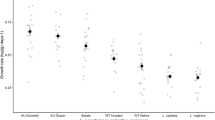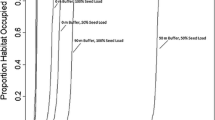Abstract
Plant domestication can increase propagule pressure and alter functional traits that may contribute to invasion risk, such as high productivity. Domesticated biotypes (i.e., any cultivar, variety, or other infraspecific taxa that have been domesticated) have a unique evolutionary history that often involves enhanced propagule pressure, selection of traits for human use, and cultural practices to increase establishment success. These elements can alter the invasion process from that of non-domesticated non-native species. Understanding which traits are consistently selected for, how strongly those traits are altered by selection, and in which cases they influence invasion risk would facilitate actions that reduce impacts of domesticated biotypes on natural and agricultural systems. We identified commonalities in trait selection and management intensity among groups of domesticated biotypes selected for particular purposes (e.g., food, ornamental, and biomass production) that indicate predictable invasion risk and management approaches for biotypes from each group. Broadly, food crops that rely on high intensity management tend to have relatively low invasion risk, while biotypes developed for ornamental purposes are subject to more variable management intensity and may have greater risk of establishment and spread in natural areas without cultural practices (e.g., weeding, fertilizer). Biomass-producing biotypes are usually bred for high productivity under low management intensity and have a high-risk of becoming invasive. For groups of domesticated plants bred for different purposes, and across all management levels, efforts to reduce risk of producing invasive biotypes include selection of parent taxa with low invasion risk, development of domesticated biotypes focused on specific low-risk traits and dependence on cultural practices, and selection of durable low-risk traits over consecutive generations.

Similar content being viewed by others
Data availability
Not applicable.
Code availability
Not applicable.
References
Anderson NO, Gomez N, Galatowitsch SM (2006) A non-invasive crop ideotype to reduce invasive potential. Euphytica 148:185–202. https://doi.org/10.1007/s10681-006-5936-6
Barney JN, DiTomaso JM (2008) Nonnative species and bioenergy: are we cultivating the next invader? Bioscience 58:64–70. https://doi.org/10.1641/B580111
Bouton JH (2007) Molecular breeding of switchgrass for use as a biofuel crop. Curr Opin Genet Dev 17:553–558. https://doi.org/10.1016/j.gde.2007.08.012
Buddenhagen CE, Chimera C, Clifford P (2009) Assessing biofuel crop invasiveness: a case study. PLoS One 4:e5261. https://doi.org/10.1371/journal.pone.0005261
Cadotte MW, Murray BR, Lovett-Doust J (2006) Ecological patterns and biological invasions: using regional species inventories in macroecology. Biol Invasions 8:809–821. https://doi.org/10.1007/s10530-005-3839-4
Campbell LG, Blanchette CM, Small E (2019) Risk analysis of gene flow from cultivated, addictive, social-drug plants to wild relatives. Bot Rev 85:149–184. https://doi.org/10.1007/s12229-019-09206-x
Cook GD, Dias L (2006) It was no accident: deliberate plant introductions by Australian government agencies during the 20th century. Aust J Bot 54:601–625. https://doi.org/10.1071/BT05157
Culley TM, Hardiman NA (2009) The role of intraspecific hybridization in the evolution of invasiveness: a case study of the ornamental pear tree Pyrus calleryana. Biol Invasions 11:1107–1119. https://doi.org/10.1007/s10530-008-9386-z
Datta A, Kumschick S, Geerts S, Wilson JRU (2020) Identifying safe cultivars of invasive plants: six questions for risk assessment, management, and communication. NeoBiota 62:81
Dawson W, Burslem DFRP, Hulme PE (2009) Factors explaining alien plant invasion success in a tropical ecosystem differ at each stage of invasion. J Ecol 97:657–665. https://doi.org/10.1111/j.1365-2745.2009.01519.x
Dehnen-Schmutz K, Touza J (2008) Plant invasions and ornamental horticulture: pathway, propagule pressure and the legal framework. Floric Ornam Plant Biotechnol 5:15–21
Denison RF, Kiers ET, West SA (2003) Darwinian agriculture: when can humans find solutions beyond the reach of natural selection? Q Rev Biol 78:145–168. https://doi.org/10.1086/374951
Diamond J (2002) Evolution, consequences and future of plant and animal domestication. Nature 418:700–707. https://doi.org/10.1038/nature01019
Donald CM (1968) The breeding of crop ideotypes. Euphytica 17:385–403. https://doi.org/10.1007/BF00056241
Ellstrand NC, Schierenbeck KA (2000) Hybridization as a stimulus for the evolution of invasiveness in plants? Proc Natl Acad Sci 97:7043–7050. https://doi.org/10.1073/pnas.97.13.7043
Ellstrand NC, Heredia SM, Leak-Garcia JA, Heraty JM, Burger JC, Yao L, Nohzadeh-Malakshah S, Ridley CE (2010) Crops gone wild: evolution of weeds and invasives from domesticated ancestors. Evol Appl 3:494–504. https://doi.org/10.1111/j.1752-4571.2010.00140.x
Flory SL, Lorentz KA, Gordon DR, Sollenberger LE (2012) Experimental approaches for evaluating the invasion risk of biofuel crops. Environ Res Lett 7:045904. https://doi.org/10.1088/1748-9326/7/4/045904
Gordon DR, Mitterdorfer B, Pheloung PC, Ansari S, Buddenhagen C, Chimera C, Daehler CC, Dawson W, Denslow JS, LaRosa A, Nishida T, Onderdonk DA, Panetta F, Pysek P, Randall RP, Richardson DM, Tshidada NJ, Virtue JG, Williams PA (2010) Guidance for addressing the Australian Weed Risk Assessment questions. Plant Prot Q 25:56
Kareiva P, Watts S, McDonald R, Boucher T (2007) Domesticated nature: shaping landscapes and ecosystems for human welfare. Science 316:1866–1869. https://doi.org/10.1126/science.1140170
Kitajima K, Fox AM, Sato T, Nagamatsu D (2006) Cultivar selection prior to introduction may increase invasiveness: evidence from Ardisia crenata. Biol Invasions 8:1471. https://doi.org/10.1007/s10530-005-5839-9
Klonner G, Dullinger I, Wessely J, Bossdorf O, Carboni M, Dawson W, Essl F, Gattringer A, Haeuser E, van Kleunen M, Kreft H, Moser D, Pergl J, Pyšek P, Thuiller W, Weigelt P, Winter M, Dullinger S (2017) Will climate change increase hybridization risk between potential plant invaders and their congeners in Europe? Divers Distrib 23:934–943. https://doi.org/10.1111/ddi.12578
Knight TM, Havens K, Vitt P (2011) Will the use of less fecund cultivars reduce the invasiveness of perennial plants? Bioscience 61:816–822. https://doi.org/10.1525/bio.2011.61.10.11
Lambertini C (2019) Why are tall-statured energy grasses of polyploid species complexes potentially invasive? A review of their genetic variation patterns and evolutionary plasticity. Biol Invasions 21:3019–3041. https://doi.org/10.1007/s10530-019-02053-2
Lavergne S, Muenke NJ, Molofsky J (2010) Genome size reduction can trigger rapid phenotypic evolution in invasive plants. Ann Bot 105:109–116. https://doi.org/10.1093/aob/mcp271
Lewandowski I, Clifton-Brown JC, Scurlock JMO, Huisman W (2000) Miscanthus: European experience with a novel energy crop. Biomass Bioenergy 19:209–227. https://doi.org/10.1016/S0961-9534(00)00032-5
Linder CR, Taha I, Seiler GJ, Snow AA, Rieseberg LH (1998) Long-term introgression of crop genes into wild sunflower populations. Theor Appl Genet 96:339–347
Lockwood JL, Cassey P, Blackburn T (2005) The role of propagule pressure in explaining species invasions. Trends Ecol Evol 20:223–228. https://doi.org/10.1016/j.tree.2005.02.004
Lockwood JL, Hoopes MF, Marchetti MP (2013) Invasion ecology, 2nd edn. Wiley-Blackwell, Chichester, West Sussex, UK
Low T, Booth C, Sheppard A (2011) Weedy biofuels: what can be done? Curr Opin Environ Sustain 3:55–59. https://doi.org/10.1016/j.cosust.2010.12.007
Mack RN (2000) Cultivation fosters plant naturalization by reducing environmental stochasticity. Biol Invasions 2:111–122. https://doi.org/10.1023/A:1010088422771
Mack RN, Lonsdale WM (2001) Humans as global plant dispersers: getting more than we bargained for: current introductions of species for aesthetic purposes present the largest single challenge for predicting which plant immigrants will become future pests. Bioscience 51:95–102. https://doi.org/10.1641/0006-3568(2001)051[0095:HAGPDG]2.0.CO;2
Mack RN, Simberloff D, Lonsdale WM, Evans H, Clout M, Bazzaz FA (2000) Biotic invasions: causes, epidemiology, global consequences, and control. Ecol Appl 10:689–710. https://doi.org/10.1890/1051-0761(2000)010[0689:BICEGC]2.0.CO;2
Maurel N, Hanspach J, Kühn I, Pyšek P, van Kleunen M (2016) Introduction bias affects relationships between the characteristics of ornamental alien plants and their naturalization success. Glob Ecol Biogeogr 25:1500–1509. https://doi.org/10.1111/geb.12520
Meyer RS, DuVal AE, Jensen HR (2012) Patterns and processes in crop domestication: an historical review and quantitative analysis of 203 global food crops. New Phytol 196:29–48. https://doi.org/10.1111/j.1469-8137.2012.04253.x
Novoa A, Le Roux JJ, Robertson MP, Wilson JRU, Richardson DM (2015) Introduced and invasive cactus species: a global review. AoB Plants. https://doi.org/10.1093/aobpla/plu078
Østerberg JT, Xiang W, Olsen LI, Edenbrandt AK, Vedel SE, Christiansen A, Landes X, Andersen MM, Pagh P, Sandøe P, Nielsen J, Christensen SB, Thorsen BJ, Kappel K, Gamborg C, Palmgren M (2017) Accelerating the domestication of new crops: feasibility and approaches. Trends Plant Sci 22:373–384. https://doi.org/10.1016/j.tplants.2017.01.004
Parrish DJ, Fike JH (2005) The biology and agronomy of switchgrass for biofuels. Crit Rev Plant Sci 24:423–459. https://doi.org/10.1080/07352680500316433
Pheloung PC, Williams PA, Halloy SR (1999) A weed risk assessment model for use as a biosecurity tool evaluating plant introductions. J Environ Manag 57:239–251. https://doi.org/10.1006/jema.1999.0297
Pyšek P (1998) Is there a taxonomic pattern to plant invasions? Oikos 82:282–294. https://doi.org/10.2307/3546968
Pyšek P, Richardson DM (2008) Traits associated with invasiveness in alien plants: where do we stand? In: Nentwig W (ed) Biological invasions. Springer Berlin Heidelberg, Berlin, pp 97–125
Pyšek P, Jarošík V, Pergl J (2011) Alien plants introduced by different pathways differ in invasion success: unintentional introductions as a threat to natural areas. PLoS One 6:e24890. https://doi.org/10.1371/journal.pone.0024890
Renard D, Tilman D (2019) National food production stabilized by crop diversity. Nature 571:257–260. https://doi.org/10.1038/s41586-019-1316-y
Richardson DM, Pyšek P (2012) Naturalization of introduced plants: ecological drivers of biogeographical patterns. New Phytol 196:383–396. https://doi.org/10.1111/j.1469-8137.2012.04292.x
Ross-Ibarra J, Morrell PL, Gaut BS (2007) Plant domestication, a unique opportunity to identify the genetic basis of adaptation. Proc Natl Acad Sci 104:8641–8648. https://doi.org/10.1073/pnas.0700643104
Salt DE, Smith RD, Raskin I (1998) Phytoremediation. Annu Rev Plant Physiol Plant Mol Biol 49:643–668. https://doi.org/10.1146/annurev.arplant.49.1.643
Sanchez-Hernandez JC (2019) Bioremediation of agricultural soils. CRC Press, Boca Raton, FL
Turcotte MM, Araki H, Karp DS, Poveda K, Whitehead SR (2017) The eco-evolutionary impacts of domestication and agricultural practices on wild species. Philos Trans R Soc B Biol Sci 372:20160033. https://doi.org/10.1098/rstb.2016.0033
van der Veken S, Hermy M, Vellend M, Knapen A, Verheyen K (2008) Garden plants get a head start on climate change. Front Ecol Environ 6:212–216. https://doi.org/10.1890/070063
van Kleunen M, Essl F, Pergl J, Brundu G, Carboni M, Dullinger S, Early R, González-Moreno P, Groom QJ, Hulme PE, Kueffer C, Kühn I, Máguas C, Maurel N, Novoa A, Parepa M, Pyšek P, Seebens H, Tanner R, Touza J, Verbrugge L, Weber E, Dawson W, Kreft H, Weigelt P, Winter M, Klonner G, Talluto MV, Dehnen-Schmutz K (2018) The changing role of ornamental horticulture in alien plant invasions. Biol Rev 93:1421–1437. https://doi.org/10.1111/brv.12402
Walsh JR, Carpenter SR, Vander Zanden MJ (2016) Invasive species triggers a massive loss of ecosystem services through a trophic cascade. Proc Natl Acad Sci USA 113:4081–4085. https://doi.org/10.1073/pnas.1600366113
Acknowledgements
We thank the University of Florida (UF) Institute of Food and Agricultural Sciences (IFAS) Dean for Research, and the UF/IFAS School of Natural Resources & Environment for funding.
Funding
University of Florida (UF) Institute of Food and Agricultural Sciences (IFAS) Dean for Research, and the UF School of Natural Resources & Environment.
Author information
Authors and Affiliations
Contributions
SLF, DL, and DRG developed the idea. TP and SC designed the figure. TP wrote the first draft of the paper. All authors provided feedback and revisions on the manuscript.
Corresponding author
Ethics declarations
Conflict of interest
The authors declare that they have no conflicts of interest.
Additional information
Communicated by Scott J Meiners.
Publisher's Note
Springer Nature remains neutral with regard to jurisdictional claims in published maps and institutional affiliations.
Supplementary Information
Below is the link to the electronic supplementary material.
Rights and permissions
About this article
Cite this article
Petri, T., Canavan, S., Gordon, D.R. et al. Potential effects of domestication on non-native plant invasion risk. Plant Ecol 222, 549–559 (2021). https://doi.org/10.1007/s11258-021-01130-8
Received:
Accepted:
Published:
Issue Date:
DOI: https://doi.org/10.1007/s11258-021-01130-8




